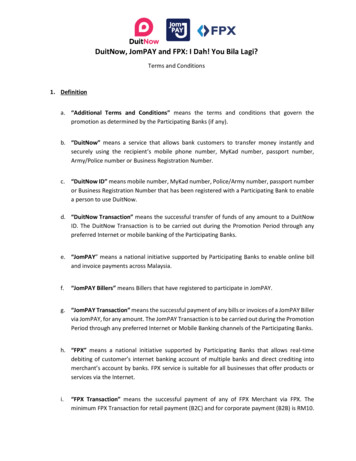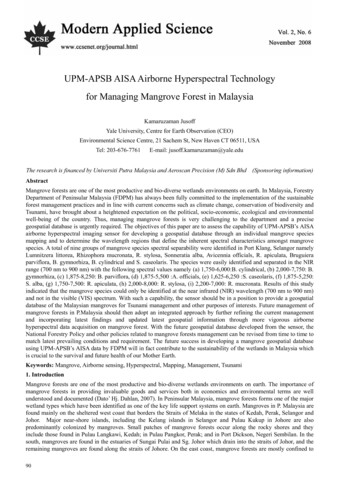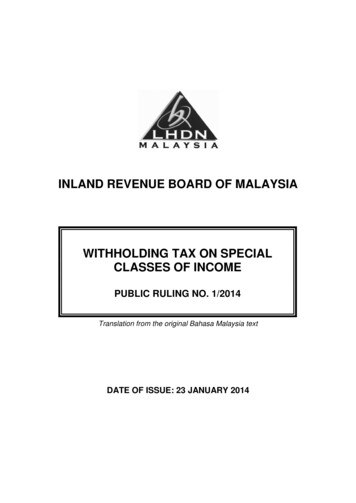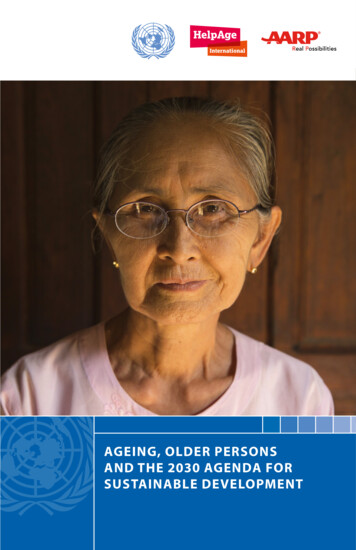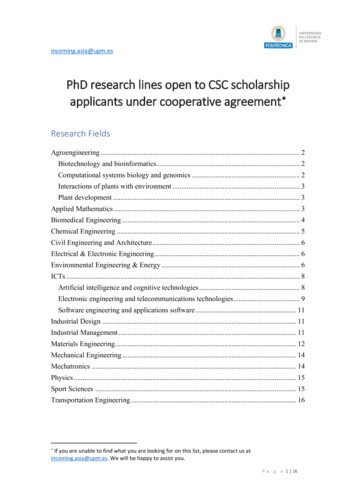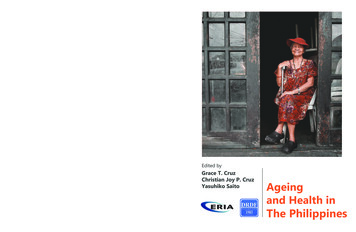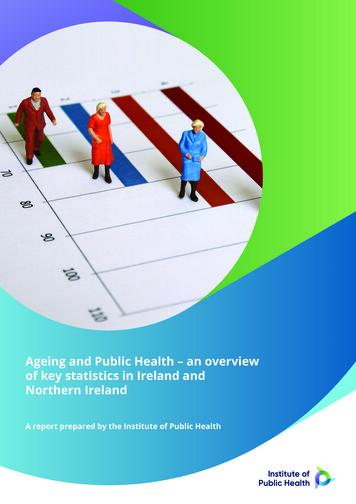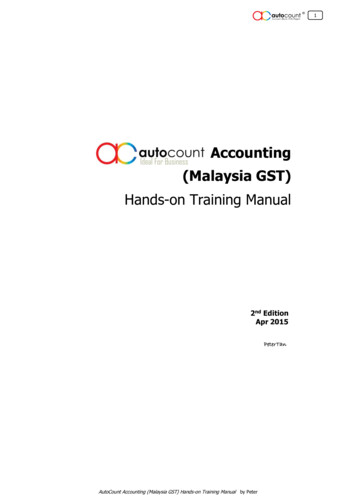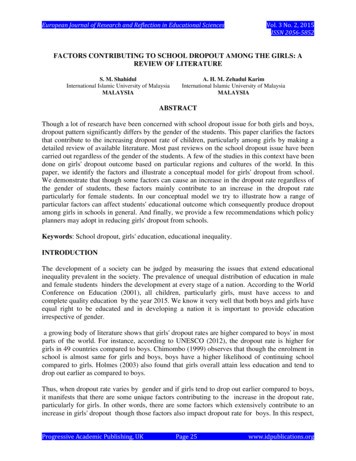
Transcription
POPULATIONAGEING IN MALAYSIAA Mosaic of Issues,Challenges andProspects
PROF. DR. TENGKU AIZAN TENGKU ABDUL HAMID
POPULATIONAGEING IN MALAYSIAA Mosaic of Issues,Challenges andProspectsProf. Dr. Tengku Aizan Tengku Abdul HamidDip. Home Tech (UPM); B.S., M.S., PhD (Iowa State University)13 March 2015Auditorium,Fakulti KejuruteraanUniversiti Putra MalaysiaUniversiti Putra Malaysia PressSerdang 2015http://www.penerbit.upm.edu.my
Universiti Putra Malaysia PressFirst Print 2015All rights reserved. No part of this book may be reproduced in any form withoutpermission in writing from the publisher, except by a reviewer who wishes to quotebrief passages in a review written for inclusion in a magazine or newspaper.UPM Press is a member of the Malaysian Book Publishers Association(MABOPA)Membership No.: 9802TypesettingCover Design: Sahariah Abdol Rahim @ Ibrahim: Marlina binti IsmailDesign, layout and printed byPenerbit Universiti Putra Malaysia43400 UPM SerdangSelangor Darul EhsanTel: 03-8946 8855 / 8854Fax: 03-8941 6172http://www.penerbit.upm.edu.my
ContentsAbstract1Introduction3Indicators of Population Ageing4Characteristics of Older Malaysians15Policies on Ageing in Malaysia26Mosaics of Issues33Prospects and the Way ledgement73List of Inaugural Lectures77
ABSTRACTThe world is ageing, and in the next decade the growth of the agedpopulation will be fastest in the developing countries. The numberof older persons is expected to more than double globally from 841million in 2013 to more than 2 billion in 2050. By then, nearly 8in 10 of the world’s older population will live in less developedregions. Rapid population ageing in Malaysia can be attributed tothe dramatic decline in fertility and mortality rates in tandem withlonger life expectancy. Compared to the more developed countries,Malaysia has a rather short time to prepare for the transition into anaged nation. The older population aged 65 years or over will takeonly 23 years to double from 7 percent in 2020 to 14 percent in2043. Like many other developing countries in the region, Malaysiais ageing at lower levels of development. All trends point towardsa rapid demographic transition that is currently taking place as a“silent epidemic”. This inaugural lecture will focus on the trendsof population ageing and the characteristics of the elderly inMalaysia from five (economic, health, social, psycho-spiritual,environmental) key domains. A discussion of the prospects and theway forward for population ageing in Malaysia is also presented.The ageing experiences of the population are influenced bynormative age-grade, normative history-grade and non-normativeevents which make each cohort of aged distinct from another asthe needs and demand of each cohort could be poles apart. Thecross-cutting dimensions of ethnicity, gender, socio-economicbackground and geographical location will influence the trajectoriesacross the life course as the situation of the aged differs by a uniquecombination of diverse past experiences. Malaysia is faced with amammoth task of balancing the needs of a rapidly ageing societyand at the same time promoting economic growth and developmentto fulfil the aspirations of becoming a high income nation. Ageing
Population Ageing in Malaysiais a multidimensional, lifelong process with impact at both microand macro levels to all members of the society. In Malaysia, thefast growth of the older population is not made opaque as thenascent knowledge on old age and ageing remains fragmented andunconsolidated. The use of empirical evidence in the planning ofpolicies on ageing must be embraced at all levels of governmentand multi-sector stakeholders should collaborate closely to optimizethe use of limited resources. The future of research on ageing inMalaysia lies in interdisciplinary studies with longitudinal paneldata, uniting the fields of social, economic and psycho-gerontology,geriatrics, as well as gerontechnology. A society for all agesrecognizes the need for lifelong development as policies designedfor the younger population will also have a binding effect on theaged today as well as those of tomorrow. 2
Tengku Aizan Tengku Abdul HamidINTRODUCTIONAgeing is a multidimensional concept which can be definedfrom many different perspectives. From a human developmentperspective, ageing is viewed as a lifelong process from conception,birth, maturity to death. From a societal perspective, ageing is seenas an aggregated statistics of the births and deaths of the populationin a society that reflected a successful health outcome of thecountry’s socioeconomic development. The environment, sociocultural and temporal context will also have reciprocal influenceon the outcomes and experience of ageing.The significance of the growth of the aged population promptedthe United Nations to convene two World Assemblies in 1980 and2002, respectively. The World Population Ageing Report (UnitedNations, 2002, p. xxviii) summarized that:1. Population ageing is unprecedented, without parallel in thehistory of humanity;2. Population ageing is pervasive, a global phenomenon affectingevery man, woman and child;3. Population ageing is profound, having major consequencesand implications for all facets of human life;4. Population ageing is enduring. During the twentieth centurythe proportion of older persons continued to rise, and this trendis expected to continue into the twenty-first century.According to the World Population Prospects database (UN,2013), there is an estimated 895.3 million older persons aged60 years or over in the world today with 504.2 million or 56.3%of them residing in Asia in 2015. By 2050, the number of olderpersons will more than double to 2 billion, where one out of everyfive persons in the world will be an elderly. At that time, the total3
Population Ageing in Malaysiaolder population, for the first time in human history, is expected tooutnumber the younger population (aged 14 years or lower). Thisdevelopment is both a triumph and a challenge to all societies. Itis a triumph because people are living longer due to better healthcare and improved living conditions. It is also a challenge becausesocieties have never experienced this large number of older personswith their unprecedented longevity.Like many other countries around the world, Malaysia is alsoexperiencing a rapid growth of the older population. This is a directconsequence of the decades of socio-economic development andpublic health policies where falling fertility and rising longevityhave resulted in the rise of new generations. The question is, whyshould Malaysia be concerned with population ageing? What is thesituation of population ageing in Malaysia? What can be done toaddress population ageing issues? This paper provides an overviewof population ageing issues and challenges in Malaysia. It willfocus on the trends of population ageing and the characteristicsof the elderly in Malaysia from five (economic, health, social,psycho-spiritual, environmental) key domains. A discussion of theprospects and the way forward for population ageing in Malaysiais also presented. Data from previous publications will be utilizedand updated throughout the paper.INDICATORS OF POPULATION AGEINGTo understand the development and significance of populationageing issues, the context in which it occurs is critical. Severalauthors have described the population of Malaysia and itscharacteristics, tracing back from her pre-Independence days tothe modern Malaysia (Caldwell, 1962, Saw, 1988, Leete, 1996).The foundation and forces which shaped the population since thecolonial days, in many ways, have perpetuated till this day. The 4
Tengku Aizan Tengku Abdul Hamiddistribution of the aged population within geographical locationsaligns with the historical development of the nation. Our multiracial and multicultural society gives rise to significant diversityin the Malaysian ageing experience and some issues may bepeculiar to specific ethnic communities. This section describes thebasic indicators of population ageing that is commonly used tounderstand the worldwide phenomenon. This will involve the use ofthe population pyramid, the measure of location (median age) andhead count ratios (dependency and ageing index). The pyramid isthe graphic representation of the age–sex distribution with definitiveshape to reflect population structure.Demographic Transition TheoryDemographic transition is a term use to describe population changeover time and the two basic processes that influence this change isbirth and death rates. The interrelationships of the two processeshave profound effect on the age structure of a country. Populationageing is a result of the changes in fertility and mortality rates as itdeclines over time (Figure 1). Malaysia is in the third stage of herdemographic transition, where fertility rates are declining faster thanmortality rates (Hamid, 2012). Figure 1 shows a steep decline inbirth rates during the 1960s up to 1970. During this time, Malaysiawas actively pursuing family planning programmes with the aim ofpromoting smaller families. Despite an effort in the 1980’s whereMalaysia pursued more pro-natalist policies with the target ofincreasing the population to 70 million people (Wong & Tey, 2006),the birth rates continue to drop. The average annual populationgrowth rate of 2.6% between the 1991 and 2000 census showed adecline to 2.0% between the 2000 and 2010 census (DOSM, 2014).Total fertility rate per women of the reproductive age reached thereplacement level of 2.1 in 2010.5
Population Ageing in MalaysiaAt the same time, the epidemiologic transition means thatthe leading cause of death had changed from communicablediseases to non-communicable diseases (or life style diseases).The top three medically certified principal causes of death in thepopulation is ischemic heart disease (12.9%), pneumonia (7.0 %)and cerebrovascular disease (6.6%) in 2008 (DOSM, 2010). Theleading risk factor for premature death in Malaysia reported in theGlobal Burden of Disease Study for 2010 was dietary risk (IMHE,2012). Life expectancy at birth has increased significantly over theyears as males born in 2010 can expect to live on average for 71.9years while it is 76.6 years for females (DOSM, 2013) (Figure 2).Life expectancy at 60 for the same year is 17.4 years for males and20 years for females (DOSM, 2011). This means that on average,older men and women in 2010 can look forward to another fifteento twenty years of retirement living. This demographic trends haveled to population age-sex structure changes and projection estimatescan help us understand the demographic transition that is happeningnow. 6
Tengku Aizan Tengku Abdul HamidNotes: CBR & CDR, 1960-62 Peninsular Malaysia; TFR, 1960-69 Peninsular MalaysiaFigure 1 Crude Birth Rate, Crude Death Rate and Total Fertility Rate,Malaysia, 1960 - 2012Source: DOSM, 2013Notes: 1996-90 Peninsular MalaysiaFigure 2 Life Expectancy at Birth by Ethnicity, Malaysia, 1966 - 2013Source: DOSM, 20137
Population Ageing in MalaysiaFigure 3 below shows the population age structure and medianage of Malaysia using the UN’s World Population Prospects data(2012 revision). The graph showed a steep drop in the percentage ofthe population aged 0-14 which started somewhere between 1965and 1970. This reflected the beginning of the decline in fertility rate.From 2010 onwards, the figure also showed a rising proportion ofthe aged population. Malaysia’s median age would grow from 26.1years in 2010 to 30.3 years in 2020 and will eventually reach 39.8years in 2050. This means that in another 35 years, half of the totalpopulation will be aged 40 years or over.Malaysia’s first demographic dividend really started in the late1970s where the demographic window of opportunity began. It isexpected to last for about 50 years where the share of the dependentpopulation will rise again. The first demographic dividend refers tothe temporary increase of the productive age population betweenthe ages of 15 to 59 years compared to the combined share ofunproductive age groups (0-14 and 60 years or over). For Malaysia,the percentage of the productive age group will peak in 2020 at69.3% and start to decline thereon. As stated by Bloom, Canningand Sevilla (2003):“ if most of a nation’s population falls within the workingages, the added productivity of this group can produce a“demographic dividend” of economic growth, assuming thatpolicies to take advantage of this are in place.” (p. xi)We are however, halfway through our demographic windowwhich will start closing by 2040 or 2050. It is possible to reap asecond demographic dividend as population at older working agesstart to accumulate assets. As people move into higher paying jobsand increase their accumulation of wealth, greater investments in 8
Tengku Aizan Tengku Abdul Hamidhuman capital will occur with rising per capita income. This is ofcourse conditional upon implementation of effective policies thatwill sustain continuous, stable and equitable growth. During thefirst dividend, individuals and families will have more resources toimprove their lives, but the second dividend depends a lot on howwell we anticipate support for the elderly. The transitory bonus of thefirst dividend can be transformed into greater assets for sustainabledevelopment. The second dividend is permanent but if we fail toutilize or invest the accumulated wealth from a one-time rise in theshare of productive age group, it may not materialize at all.Between 2050 and 2055, the number of older persons aged 60years or over will equal the number of young people under the ageof 15 years in Malaysia. All these changes will have significantimplications on our economy and our society. Lee, Mason and Park(2012) have argued that Asian countries faces two major objectivesin relation to population ageing; 1) sustaining strong economicgrowth, and 2) providing economic security to the increasingnumber of older persons. They stressed the need to promote savings,investment in human capital, as well as well-functioning financialand labour markets including micro economic stability, whiledisagreeing with the provision of large transfer programs for olderpersons. Their concerns echoed the opinions of Bloom, Canningand Saville (2003) in which they stressed that the approach adoptedby governments to address population ageing issues will influencethe productivity and economic growth of the nation.9
Population Ageing in MalaysiaFigure 3 Population Age Structure and Median Age, Malaysia,1950-2100Source: Author’s calculation based on the World Population Prospects: The 2012Revision (UN, 2013)Age-sex PyramidThe age-sex distribution of the population can be showngraphically in the form of the population pyramid. Head-countratios (dependency ratios, ageing index) only relate the numberof individuals in large age categories and do not take into accountage distribution within the smaller categories, especially amongthe elderly group (Gavrilov & Heuveline, 2003). A more precisepresentation of changing age structure that takes into considerationvariations in age distribution is the population pyramid.Youthful population is represented by pyramid with a broad baseof young children and a narrow apex of older people, while olderpopulation would have a more even age sex distribution across agesor even develop column or an inverted shaped pyramid. During thedemographic transition process the age structure of the population 10
Tengku Aizan Tengku Abdul Hamidchanges from a broad-based pyramid shape with high proportionof children to a more columnar shape with increasing proportionof middle-age and older persons. The change in age structure canbe seen clearly in the population pyramid below. The shape of ourpopulation pyramid (Figure 4) has changed from the triangularshaped pyramid to becoming a column with a narrowing of the lowerage groups and expansion in the middle age groups. This showedthat the productive age groups are expanding and at the same timethe older population is also increasing as the younger populationshrinks.Figure 4 Age-sex Pyramid, Malaysia, 1970-2020Source: Author’s illustration based on the World Population Prospects:The 2012 Revision (UN, 2013)11
Population Ageing in MalaysiaMedian AgeThe median age is another indicator used by demographers to denotepopulation ageing. The median age is the age at which exactlyhalf of the population is older and half is younger than the saidage. The median age of Malaysians showed a declining trend from1950s to 1965, and steady increase thereafter as shown in Figure1. Demographers use age 30 as the cut-off median age to indicatewhether a population is ageing (Hamid, 2006). Population with amedian age below 20 years is considered young, whereas populationbetween the ages 20-29 years is intermediate, while 30 years andabove is deemed old. Looking at the population projections in Figure1, Malaysia can achieve the aged nation status as early as 2020 ifusing median age as the indicator.The year 2020 is a very significant milestone for Malaysia’sdevelopment as it is the year when the country should achieve thegoal of becoming a developed nation as envisioned by Tun Dr.Mahathir Mohamed. It is apt that at the juncture of turning intoa developed state, the country should consider the implicationsof a rapidly ageing society. Declining fertility rate contributesto population aging by depressing the growth rate of youngerpopulation, creating a faster growth rate of older populationcompared to younger population, thus promoting ageing fromthe base of the population pyramid. At the same time, the lifeexpectancy at birth and at age 60 year hastened the growth of theolder population (Hamid, 2012). In developed nations, ageing ishappening at the apex of the pyramid as declining death rates atolder ages and the large birth cohort from the past such as babyboomers is living longer contributed to the number and proportionof older persons. 12
Tengku Aizan Tengku Abdul HamidDependency RatiosFigure 5 provide two indicators based on head count ratio(dependency ratio and ageing index) that present a crude measureof economic burden. The total dependency ratio is the numberof persons under age 15 plus persons aged 65 or older per onehundred persons 15 to 64. It is the sum of the youth dependencyratio and the old-age dependency ratio. Population below age 15and above age 65 are considered as non-productive age groupsand the population aged 15-64 is defined as productive from theconventions of population demography.Figure 5 Dependency Ratios and Ageing Index, Malaysia, 1950-2100Source: Author’s calculation based on the World Population Prospects: The 2012Revision (UN, 2013)As can be seen with this latest medium projections, the totaldependency is on a decline from 1965 to 2020 and this changes toan upward trend from the year 2020 onwards. The upward trendfrom year 2020 is due to the increase in the aged dependency13
Population Ageing in Malaysiaratio indicating the growing contribution of the number of olderpersons in the society to the total dependency ratio. As for the youthdependency ratio the downward trend continues sharply from 1965to 2020 and a gradual reduction occurs from then on.Ageing Index and Other IndicatorsThe ageing index is a measure ratio of young to old persons in thepopulation. The ageing index is calculated as the number of persons60 years old or over per hundred persons under age 15 (Figure 5).In 1950, there were approximately 18 older persons to 100 youngMalaysians aged below the age of 15. The downward trend wasnoted from 1955 onwards till 1995, when there was a reversal. Asteep upward trend, about 21 older persons to 100 young personsbelow the age of 15 started in 2005. In 2010, there were about 25older persons to 100 young person ages below 15 year old andthis is projected to reach 197.5 persons in the year 2100. Ageingindex of less than 15 is considered young, while an index of over30 is considered as old (Hamid & Abu Samah, 2006), Using thisindicator, Malaysia will be an aged nation by 2020. In the year2055, the ageing index will surpass 100, indicating more elderlypopulation compared to young population.Other indicators of population ageing include parent supportratio and potential support ratio. Both ratios estimate thegenerational support to older persons in the population. The parentsupport ratio is the number of oldest-old (persons aged 85 years orover) per one hundred persons aged 50 to 64 years, The potentialsupport ratio refers to the number of persons aged 15 to 64 yearsper every older persons aged 65 years or over (UN, 2002). 14
Tengku Aizan Tengku Abdul HamidCHARACTERISTICS OF OLDER MALAYSIANSOne of the most significant aspects of population ageing inMalaysia the fact that it is happening at lower levels of developmentcompared to other countries. Like most developing nations, thespeed of population ageing is way more rapid than the developedstates and the growth of the aged population. The characteristicsof older Malaysians are also deliberated in terms of sex, ethnicity,geographical dispersion and area density. These cross-cuttingdimensions will result in different ageing experiences for the olderpopulation.Ageing at Lower Levels of DevelopmentThe bubbles in Figure 6 show the comparative size of agedpopulation in the selected countries in relation to the gross nationalincome. As a case in point, many countries in Asia are getting oldbefore getting rich. Thailand’s share of older population is almostsimilar to Singapore’s but their GNI per capita is nowhere nearcomparable. Compared to Malaysia, Thailand, Sri Lanka, Vietnamand many other Southeast Asian countries are ageing rapidly witha notable exception that is the Philippines.The size of Malaysia’s aged population among the ASEANnation is still much smaller compared to Indonesia, Vietnam,Thailand, and the Philippines. It is however, larger than Singapore,Brunei, Cambodia, and Lao PDR. Comparatively Singapore hasa very small percentage of the aged population and a high grossnational income per capita, while China has the biggest percentageof aged population but her gross national income is much smallerthan Singapore. Hence, it will be a bigger challenge for China todesign policies and programmed compared to Singapore. On theother hand, for Malaysia the magnitude of the aged problem is15
Population Ageing in Malaysiasomewhat still limited as presented by the graph. However, we areageing at lower levels of development and we are ageing at a rapidspeed. Therefore there is an urgency to prepare the nation for theeventuality as it takes more than a decade for social institutions tochange. Strategic approaches need to be designed to avert the crisisof old age in Malaysia and at the same time addressing the needsof other sectors of the population.Figure 6 Ageing at Lower Levels of Development, 2013Source: Author’s calculation based on the World DataBank (World Bank, 2014)Speed of Population AgeingThe speed of growth of the aged population is alarming especiallyfor the developing nation (Figure 7). In developed nations theprocess of population ageing is in tandem with the developmentof social infrastructure and the nations were rich before theybecome old. On the other hand, in the developing countries theyare becoming older before becoming rich as noted by the formerdirector of the World Health Organization during the Second WorldAssembly on Ageing 2002. The figure showed that France took over 16
Tengku Aizan Tengku Abdul Hamid100 years to double her population aged 65 years and over from 7percent in 1865 to 14 percent in 1980. Similarly, Sweden took 85years, while United States took 68 years and the United Kingdomtook 45 years. Japan only took 26 years to double her populationaged 65 years and over from 7% to 14%. Now one in four of Japan’spopulation is aged 65 years and over (Kinsella and He, 2009).Figure 7 Speed of Population Ageing in Selected CountriesSource: Kinsella & Gist, 1995; Author’s calculation based on the InternationalData Base (US Census Bureau, 2013)The developing countries at the turn of the millennium showedmuch faster increase. China will only take 22 years to double herpopulation aged 65 years and over in from 2001 to 2023, whileSingapore and Korea will only take 20 and 18 years, respectively.Malaysia will take about 23 years to double her population aged65 years and over. Vietnam will only need 16 years to make thesame transition. Lower fertility rate, longer life expectancy andgood public health care in developing countries contributed to therise of the aged population. Nonetheless, the rapid increase is notin tandem with the resources needed to cater to the needs for agedcare and services as noted earlier.The cut-off age of 65 years old and the 7% mark has also beenused to indicate aged nation status. Singapore in the year 200017
Population Ageing in Malaysiaachieved an aged nation status when older persons aged 65 yearsand over make up 7% of the island’s total resident population (UN,2013). Malaysia’s population will comprised of 7 percent aged65 years and over in 2020. The year 2020 is very significant forMalaysia as she aimed to achieve a developed and high incomenation. Nonetheless, the demographic indicators also revealed thatMalaysia will become an aged nation status by 2020. This impliedthat Malaysia has to be fully prepared to accommodate the changingdemand for an aged nation.Growth of Older PopulationThe figure below represents the growth of older population inMalaysia from 1950- 2100. The number of older persons 60 yearsand over show an increasing trends since 1960. A notable increasein percentage of older population started in the year 2010 when itincreased by more than 1.5% in 10 years. They have doubled overthe last twenty years, from 1.02 million in 1990 to 2.19 millionin 2010. This figure is expected to hit 3.52 million or 10.71% ofthe total population in 5 years’ time. During this period, 1 out ofevery 10 persons in Malaysia will be and older persons. The totalpopulation of Malaysia will reduce gradually starting from the year2070 onwards. 18
Tengku Aizan Tengku Abdul HamidFigure 8 Growth of Older Persons in Malaysia, 1950 - 2100Source: World Population Prospects: The 2012 Revision (UN, 2013)Older persons in Figure 8 are categorized into three age cohorts,those in their 60s (60-69 years), 70s (70-79 years) and 80s or older(80 years and over). The data from the United Nations’ populationdatabase clearly indicated the steady growth of the oldest-old agegroup. From 1950-2050, more than half of the older Malaysians isfrom the 60-69 age group. Starting from the year 2000, the shareof the older population aged 70 years or older is growing and willincrease substantially. Percentage of the young-old is projected todecline over the next century compared to the older age groups.19
Population Ageing in MalaysiaFigure 9 Growth of the Older Population in Malaysia, 1950 - 2100Source: World Population Prospects: The 2012 Revision (UN, 2013)Looking at the octogenarian (80 ), the composition seems tohover around 8% between 1970 and 2020. From 2030, octogenariansis projected to comprise ten percent of the older population and willtriple over the next four decades. By the year 2100, all three agecohorts will have equal share of at least 30% of total population age60 years or over in Malaysia. As noted by Loke and his colleagues(2013), older Malaysians recorded higher levels of disability withinsimilar age cohorts when compared to older Australians. With thegrowth of the old-old and oldest-old in the population, there willbe higher functional disabilities and frailty in the society. This callsfor special services to address the needs of frail and disabled olderpersons.Sex and Ethnic DifferencesGender is another salient feature in population ageing as thedemographic characteristics between male and female older personsare quite distinct. Female older person is blessed with longer life 20
Tengku Aizan Tengku Abdul Hamidexpectancy and many will outlived their spouses. Therefore, manyolder women will be widowed (Hamid et al. 2006, DOSM, 2013).Nonetheless, women and men experience different life trajectoriesacross their life span which leads variant ageing experiences.This lead to the feminization of old age and this is a universalphenomenon.The ethnic dimension of Malaysia’s population characteristicsprovides different ageing experiences. In terms of life expectancy,female Chinese life expectancy at birth is the longest with 75.0for male and 79.7 for female, followed by Bumiputera with 71.3for male and 76.1 for females in 2013 (DOSM, 2014). Similarlylife expectancy at age 60 favours ethnic Chinese, where males canexpect to add another 19.6 years and female add another 22.3 years.Bumiputera and Indian males can expect to add another 17 years,while Bumiputera and Indian females can expect to add another 20years. Hence, ethnic Chinese, due to their longevity in life recordedhigher number of aged population compared to other ethnic groups(Table 1).21
2270.664.4ChineseIndian19.115.2IndianSource: Department of Statistics (1986; 1993; 2002; 2013)* Peninsular Malaysia 0Malay & B.Total16.169.0Malay & B.At 6068.9Female1990*MaleTotalAt 6.279.776.177.2Female2013eTable 1 Life Expectancy at Birth and at 60 years by Ethnicity, Malaysia, 1990 - 2013Population Ageing in Malaysia
20102020203020401,854.601,540.301,15
brief passages in a review written for inclusion in a magazine or newspaper. UPM Press is a member of the Malaysian Book Publishers Association (MABOPA) Membership No.: 9802 Typesetting : Sahariah Abdol Rahim @ Ibrahim Cover Design : Marlina binti Ismail Design, layout and printed by Penerbit Universiti Putra Malaysia 43400 UPM Serdang
